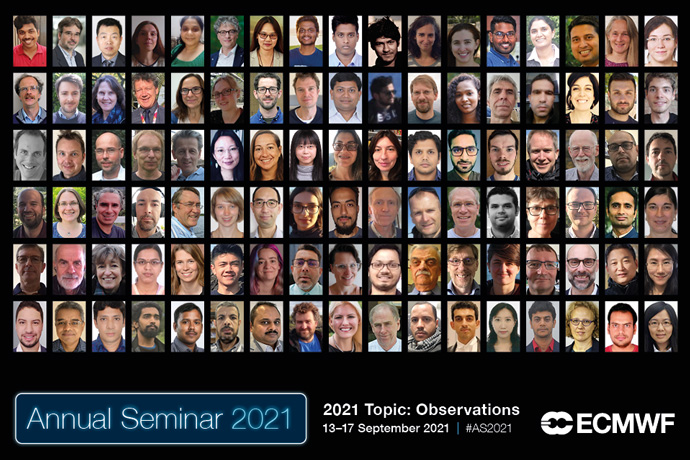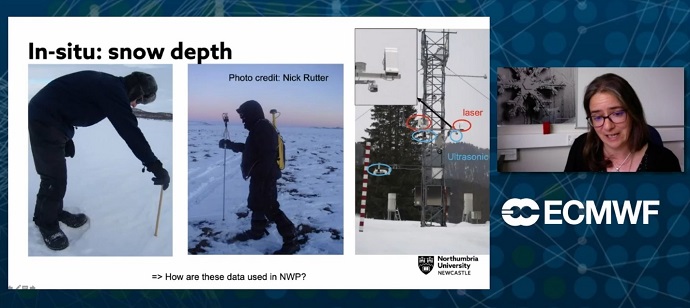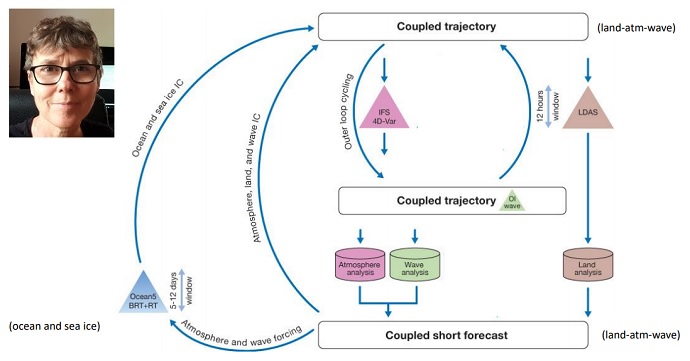

Some of the attendees at ECMWF’s Annual Seminar 2021.
Thirty-seven experts set out the latest thinking on Earth system observations at ECMWF’s Annual Seminar 2021 from 13 to 17 September.
The online event was held jointly with the World Meteorological Organization (WMO) WCRP–WWRP Symposium on Data Assimilation and Reanalysis.
The Gather.Town meeting tool was used to integrate the two virtual events into one. This enabled informal interactions between the 520 attendees as well as ease of movement between the formal sessions and poster viewing.
The Seminar explored how the Earth system approach is changing requirements for observations and using them.
“Many new observations are radically different to traditional meteorological observations in their characteristics, whilst others are long established but never fully exploited,” said Stephen English, the Head of ECMWF’s Earth System Assimilation Section. “This was very much reflected in this year’s Seminar talks, with remarkable progress and exciting new developments summarised.”

Stephen English introduced the Annual Seminar 2021.
Current observations
A common theme throughout the week was how the use of many observations is limited by the maturity of scientific understanding. This can be gaps in radiative transfer modelling or in describing observation errors well enough, as well as aspects related to quality control.
Observations may also simply not be shared: Melody Sandells (Northumbria University, UK) showed the importance of sharing in-situ snow observations, which has improved significantly in recent years.
It is, of course, also important to acquire new types of observation to fill gaps, and the large impact of the Aeolus satellite measuring winds was noted by multiple speakers.

Christina Köpken-Watts (DWD) showed the remarkable impact of Aeolus data being found at several centres, with results shown at the Annual Seminar by both DWD and ECMWF.
John Siddorn (NOC) made the point that the ocean observing system has a fragile funding state, and in-situ observations remain vital for sub-surface information.
Bruce Ingleby (ECMWF) showed how, despite the importance of aircraft observations, the robustness of the rest of the observing system meant the loss of aircraft observations during the COVID-19 pandemic has been managed.
Several speakers noted the importance of multi-parameter estimation across Earth system components, which fits well in the context of coupled Earth system assimilation for numerical weather prediction.
Antje Inness and Angela Benedetti (both ECMWF) showed the strong linkages between atmospheric composition observation for composition analysis and forecasting, but also to support weather prediction. Here the lack of vertically resolved observations is an issue, especially with uncertainty over the future of limb sounders.
Cristina Charlton-Perez (UK Met Office) noted the importance of land observations to multiple application areas, including weather, hydrology and climate forecasting; therefore, land observations have high societal benefit in agriculture, flooding, drought, heatwave and wildfire prediction.

Melody Sandells (Northumbria University, UK) showed the evolution of surface snow depth observations.
Practical aspects
The talks on day two considered generic practical aspects common to all observations. Peng Zhang (CMA) described WMO and CGMS efforts to design and coordinate the global observing system, and how agencies ensure high quality raw observations with well understood error characteristics can be provided to users.
Despite these efforts, observations are often difficult, and Nigel Atkinson (UK Met Office) talked through many examples of the type and range of issues encountered, exploring to what extent they are understood and correctable at source.
Peter Lean (ECMWF) addressed what such issues can mean in an operational system, how their impact can be managed, and how systems can be made more robust. He also showed how we can try to ensure that we are using more of the available observations, to ensure the forecast begins with the best possible analysis available at the time. One aspect of this is the capability and cost of modelling the observations, ready for their use in data assimilation systems.

Peter Lean described how Continuous Observation Processing for ECMWF (COPE) can enable observation quality issues to be detected and responded to before the operational critical path.
Patrick Eriksson (Chalmers University of Technology, Sweden) showed efforts in this area for new and existing microwave observations. The end point of these efforts is to ingest the observations into the analysis in order to initialise the new forecast.
Mark Buehner (Environment and Climate Change, Canada) gave an overview of the state of the art in the data assimilation methods available and used at operational centres.
Current challenges
On day three, some examples of challenges which are considered important in the community at this time were presented.
Jo Waller (UK Met Office) talked about observation correlation. She noted that recent success has been achieved by explicitly modelling spectrally correlated error for hyperspectral and microwave radiance observations, and this is motivating a detailed look at other sources of error correlation, notably spatial error correlation.

Jo Waller (UK Met Office) presented the challenge of correctly accounting for spatially correlated error – like some ECMWF speakers, she spoke from ECMWF!
Patrick Laloyaux (ECMWF) continued the theme on systematic errors, presenting current ideas and challenges in the area of bias aware data assimilation, particularly when that bias arises from the forecast model in a data assimilation (DA) context.
Catherine Prigent (CNRS/Observatoire de Paris/Estellus) presented some challenges that arise in trying to correctly understand observations sensitive to both the atmosphere and the surface. This is a class of observation with high potential in a coupled DA framework (sometimes called interface observations).
This led naturally to the talk by Patricia de Rosnay (ECMWF) on Coupled DA challenges, in which she explained the concepts being used or explored in operational centres, and showing ECMWF’s recent progress in this area.
Lastly, Kirsten Bathmann (NOAA) examined quality control issues for satellite and in-situ data. She focused mostly on infrared and GNSS observations, but also explained the variational quality control approach, its role, what options exist and why it is important.

Patricia de Rosnay explained different approaches to coupled data assimilation being applied and evaluated at ECMWF.
Observation quality and impact assessment
The fourth day of the Annual Seminar focused on assessing the value of observations. Mohamed Dahoui (ECMWF) presented monitoring and related diagnostics. The number of observations used is now so high it produces 140,000 plots, necessitating an automatic system to detect anomalies and generate alerts.
Reanalysis issues were addressed in two joint sessions with the WMO Symposium, with a longer talk by Shinya Kobayashi (JMA), and shorter talks by Hans Hersbach (ECMWF), Laura Slivinski (NOAA), Joaquin Munoz-Sabater (ECMWF), Bill Bell (ECMWF), Amal El Akkraoui (NASA) and Deep Sankar Banerjee (CMCC). ECMWF is considering a dedicated Annual Seminar on reanalysis in 2023.
Philippe Chambon (Météo-France) gave a detailed talk on the value of observations for cloud and precipitation in the context of all-sky assimilation, showing both the remarkable progress achieved and encouraging a consistent approach across all spectral regions and passive and active systems.
Niels Bormann (ECMWF), Elisabeth Remy (Mercator Ocean) and Jana Kolassa (GMAO) gave overviews of recent impact assessments for observations in the atmosphere, ocean and land systems. They also described methods to inform the future evolution of the Global Observing System.
Niels showed how all observations are contributing to forecast skill, but recently GNSS has risen in importance as the number of observations available has increased.
All three stressed the need for science improvements (e.g. better handling of correlated observation error), new observations (e.g. SWOT), and regular updates of impact assessments as systems evolve.
Jana noted that impact assessments for land tend to focus on areas already rich in observations, and impact in data-sparse areas is likely higher, but hard to assess.
Future observations
The final day of the symposium looked to the future. Dorothee Coppens (EUMETSAT), Craig Donlon (ESA) and Natalia Donoho (NOAA) looked to the future evolution of space-based observations, focusing on operational, research and Earth system aspects.
It was noted that we live in a golden age for Earth observation, which a remarkable array of different observations. But despite this there remain aspects that are under-observed, and also some observations that are under-utilised.
Tony McNally (ECMWF) reflected on different aspects that define the value of observations. He noted that there are aspects intrinsic to the observations, other aspects that depend on how they are used, and thirdly aspects that are less direct but just as important, such as how high-quality observations enable model improvements.
Roger Randriamampianina (Met Norway) gave a wide-ranging review of new types of surface-based observations that are becoming available, such as observations from cars and smartphones.
Alan Geer (ECMWF) ended the week by talking about the all-sky, all-surface approach at ECMWF. He showed that the lack of impact from satellite data in the polar winter regions, reported by earlier speakers, also extends to other remote land areas in the winter. This is surprising because we expect satellite observations to be important in remote areas, where usually there are few or no surface-based observations. Alan noted that a key problem to solve is surface radiative transfer to unlock these underused satellite observations.

Alan Geer (ECMWF) presented the ‘all-sky, all-surface’ approach that aims to unlock underused observations in remote land and polar areas in winter.
Further information
Recordings of the talks and presentations are available on the Annual Seminar programme page of the Annual Seminar 2021 website.
